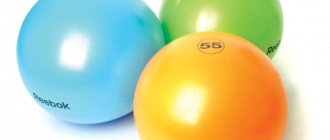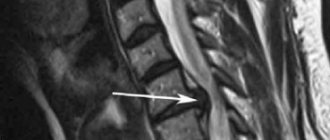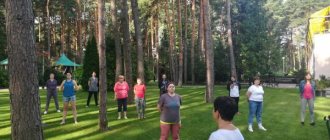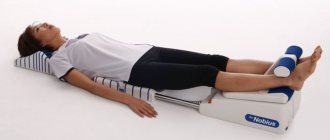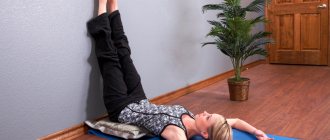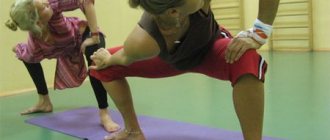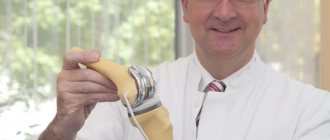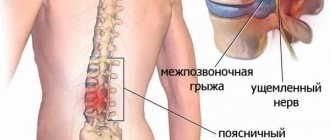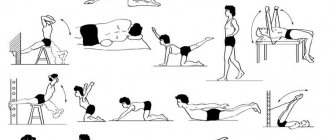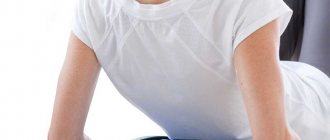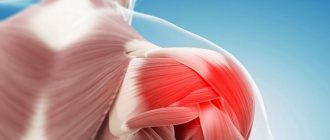Disruption of the muscles of the thoracic spine leads to various types of pain in the thoracic back, in the ribs, across the entire shoulder girdle and in the neck. It is difficult to identify a clear reason for such violations. This can be either a lack of training or chronic overload, carrying heavy objects, hypothermia, stress, etc. All this leads to shortening of the back muscles and spasms, which causes pain.
The thoracic spine is the least susceptible to the formation of hernias and protrusions, but sometimes they are found there too. Comprehensive strengthening of the back and deep muscles of the spine means the absence of pain and the key to the health of the entire spine, as well as excellent prevention against intervertebral hernias and protrusions.
A set of effective and simple exercises at home will help you independently restore and strengthen the muscles of the thoracic spine and cure a sore back.
My personal recommendation: before starting the exercises, undergo 2-3 sessions of deep massage and PIR (post-isometric relaxation) from a qualified muscle dysfunction specialist.
Clothes should be loose, it is advisable to remove shoes. Perform all exercises (especially the first days) smoothly and gradually. Remember the important principle: “Endure mild pain, do not allow severe pain.”
Do these exercises daily for at least 2 weeks.
What is back stretching?
Spinal stretching is a set of exercises to improve the condition of the back muscles, increasing their strength and at the same time elasticity. Its implementation has a general strengthening, tonic effect on the skeletal muscles of the entire musculoskeletal system. Stretching, or traction of the spine at home, is an important part of the treatment of diseases, including cervical, thoracic, lumbar osteochondrosis, and deforming spondyloarthrosis. Strong muscles reliably stabilize discs and vertebrae and prevent their displacement.
Exercise therapy for the thoracic spine
To treat the thoracic spine, the following set of exercises is used:
- Shoulder rotation: forward, backward, out of order. 10 approaches per exercise.
- Starting position: sitting on a chair. We sit comfortably and lean on the back, move our shoulders back, and push our pelvis forward, as if “hanging” on the back. We feel the joints unblocking, you can hear a slight crunching sound.
- Sitting on the floor, bend your knees and grasp your feet from the inside. We round the spine and begin to make smooth rolls with our backs along the floor, 3-5 times.
- We lie on our stomachs, leaning on our forearms. We try to lower the stomach as low as possible, not by muscle effort, but under the influence of gravity, and hold for 10–30 seconds. Then we put our hands on our elbows and lower our head on our palms. Having relaxed as much as possible, we stretch the mid-thoracic spine, also for 10–30 seconds.
- We take a gymnastics stick or a small roller, place it on the floor and lie with our backs on the stick so that it is at the level of the shoulder blades. We lie down for 5–10 seconds, then clasp our elbows and slowly lower our hands behind our heads, stretching in this way for 20–30 seconds. The lower back is pressed to the surface. Moving the stick to lower parts of the spine, we repeat abducting the arms behind the head. After stretching the entire thoracic region, you can repeat the rolls.
What are the benefits of stretching for the spine?
Many spinal pathologies cannot yet be completely cured. To prevent the patient from suffering from back pain and stiffness, analgesics are prescribed. But with long-term use of drugs, their pronounced side effects appear. Therefore, doctors recommend that patients radically solve the problem by stretching the spine:
- eliminate all symptoms;
- stop the spread of the disease to healthy tissue.
Stretching increases the spaces between the discs and vertebrae. They stop squeezing blood vessels and spinal roots. And the resulting bone growths (osteophytes) no longer injure soft tissues, provoking the development of inflammation.
Indications for exercises
Stretching the back muscles can be recommended both for osteochondrosis and for its complications that have already developed - protrusion or intervertebral hernia. And spinal traction for hernial protrusions, performed by chiropractors, often avoids surgical intervention. In what cases is stretching the back muscles therapeutically effective:
- for aching, pressing, nagging pain in the cervical, thoracic, lumbar region that occurs after physical exertion, hypothermia, changes in weather;
- with morning stiffness, which disappears only after 30-40 minutes;
- with increased headaches, dizziness, tinnitus, double vision of objects in front of the eyes, indicating developing vertebral artery syndrome.
Regular stretching of the spinal muscles is necessary to prevent osteochondrosis for people at risk. The disease develops due to excess weight, prolonged stay in one body position, and excessive stress on the spine.
What causes lower back pain?
Most often, a pinched lower back takes you by surprise: it becomes painful to move, and the person panicsly tries to figure out what to do. This condition can be avoided by knowing in advance what reasons lead to an unpleasant ending. Here are some of the most common factors:
- Inadequate physical activity. For example, lifting heavy weights, especially in people with little training.
- Displacement of the lumbar vertebrae, dislocation, and other dangerous back injuries.
- Hypothermia, prolonged exposure to low temperatures (for example, in water).
- Neoplasms of various types.
- Osteochondrosis. Calcification of bone tissue and thinning of the cartilage of the intervertebral discs lead to a reduction in the distance between the vertebral bodies. Because of this, the nerve roots coming out of the spinal cord are pinched.
- Protrusion of an intervertebral disc into the spinal canal (protrusion) or outward, with a herniated intervertebral disc. Even if the integrity of the cartilaginous ring is preserved, mobility is greatly affected.
- Overweight. Additional kilograms increase the load on the spinal column. The process develops in a similar way when carrying a child, when additional kilograms and a shift of weight forward, onto the stomach, can lead to compression of the nerves.
- Lack of vitamins and minerals. It occurs due to poor nutrition and leads to degenerative changes in the bones, including the development of osteoporosis.
- Incorrect posture, scoliosis, stoop.
- Sedentary work, lack of mobility. An uncomfortable sleeping place, leading to an unnatural posture in which the spine cannot fully straighten.
Signs of a pinched nerve in the lower back occur with pathological changes in the spine and intervertebral discs. The condition can be provoked by infectious diseases, degenerative changes in bone and cartilage tissue. Tolerating the sensations and hoping that it will go away on its own, or to self-medicate, is dangerous. It is necessary to find out why the disease occurred. Therefore, you need to contact doctors who specialize in treating the spine and joints. They recognize the problem in time and find a way to keep the patient healthy.
General rules for stretching
Most stretching exercises are static. This means that you do not need to make intense movements when performing them. However, a preliminary warm-up is necessary to prepare the muscles for the upcoming loads. Exercise therapy doctors advise walking around the room, raising your knees high, bending forward, backward, and turning in both directions. The following rules should also be observed:
- movements should be slightly slow;
- if painful sensations appear, training should be stopped and continued only after rest;
- When performing exercises, you should stay in the stretching position for 10-20 seconds;
- breathing should be even, deep, rhythmic.
It is not necessary to perform all the exercises at once - the load should be increased gradually. If any movement causes pleasant sensations in the back muscles, then it can be repeated in 2-3 approaches.
When is spinal traction used?
This is a very controversial issue for specialists. Some claim that stretching is beneficial for almost everyone, while others prohibit their patients from doing the exercises.
Here you need to rely on your feelings and the opinion of the attending physician whom you trust. He will definitely be able to choose a complex that is right for you.
Well, a roller is useful for everyone - these days, almost everyone complains of back and neck pain. This is not surprising, because our lifestyle has become sedentary. Therefore, be sure to set aside 5 minutes from your day for static gymnastics.
Exercise equipment and devices
Rehabilitation centers are equipped with the most modern spinal traction machines. But there are devices that can be purchased in specialized stores for training at home.
Horizontal bar
Hanging on the horizontal bar is indicated for patients with protrusions or intervertebral hernias of the lumbar and thoracic region. If the cervical discs and vertebrae are damaged, this type of stretching is not used due to the high risk of muscle overstrain and deterioration of well-being. You need to hang on the horizontal bar for several minutes 3-4 times a day.
Evminov simulator
The Evminov simulator is a wide, fairly flexible pine board, equipped with several brackets or handles for holding the limbs. Typically, the exercises are performed in a lying position, face down or up. The person rests his feet on the floor and smoothly moves his body first up and then down.
Gleason loop
The Gleason loop, or traction loop, is designed to increase the distance between vertebrae and strengthen the muscles of the upper body. The device is most in demand for osteochondrosis, osteoarthritis, scoliosis, and intervertebral hernias. The Glisson loop is a frame for housing the head with a complex system of straps and fasteners. It is attached with a cable at a certain height. When the load, the weight of which is calculated by the doctor, is displaced, the spinal muscles are stretched.
The essence and benefits of therapy
The spinal column is a single, holistic system consisting of 33-35 individual bones (vertebrae), forming 4 sections:
- cervical;
- chest;
- lumbar;
- sacral.
Normally, these vertebrae have natural curves and have a certain mobility relative to each other, which allows a person to bend forward and backward, turn the body, lift weights and perform other movements.
However, due to various factors, the vertebrae may begin to shift.
This is caused by various reasons, which can be conditionally grouped into 2 large groups:
- Long-term exposure factors include a “sedentary” lifestyle, improper lifting of heavy objects.
- Factors of immediate impact are injuries (dislocations, fractures, bruises, etc.).
As a result of the displacements, the vertebral bones can literally squeeze each other, affecting the discs located between them. Therefore, the essence of traction therapy (from the Latin “extensio” - “pull”, “drag”) therapy is precisely based on the fact that stretching the spine contributes to the natural return of the bones to their original, normal position.
The benefit of traction on the device is expressed in the fact that the procedure allows:
- significantly increase the distance between the vertebrae, which has decreased as a result of pathology or injury;
- fight vertebral hernias due to the fact that the disc ceases to experience excess pressure from the bones, as a result of which the destruction of its structure gradually stops;
- improve posture - restoration of a displaced vertebra helps bring the entire column to a normal physiological state;
- improve blood supply in those vessels that directly nourish the bones of the spine along its entire length;
- Thanks to blood flow and increased metabolic processes, the natural restoration of vertebral cells improves and swelling is relieved.
Gymnastics for stretching the back and spine
A set of gymnastic exercises is compiled by a physical therapy doctor, taking into account the type of disease, the severity of its course, and the general health of the patient. He conducts the first classes, shows how to correctly perform movements and dose the loads on the back muscles. After 1-2 weeks, you can successfully train at home.
"Camel Cat"
Get on all fours, straighten your shoulders, sway a little from side to side. Slowly bend your lower back, imitating the stretching of a cat, and then arch it, rounding it. You should stay in each position for 10 seconds. The number of approaches is arbitrary.
Crossing your legs
Lie on your back, stretch your arms along your body or place them under your head. Bend your knees and place your feet on the floor. Extend your right leg and throw your left knee over it, trying to touch the surface of the mat. Repeat the exercise 7 times, and then perform it in the other direction.
Turn your back on a chair in different directions
Sit on a chair or stool, grab the seat with your hands. Slowly turn the body, first in one direction, then in the other, holding this position for 20 minutes. Repeat movements 10-15 times. When performed correctly, the exercise places the load on the muscles of the shoulder girdle.
Squat bends
Stand up straight, place your feet shoulder-width apart so that your toes point slightly to the sides, not inward. Sit down, touching your hands to the floors, and then straighten your legs without lifting your heels and palms from the floor. The number of approaches is 5-10.
"Mermaid"
Sit on the mat, place your knees bent to your right, holding them with your right hand. Stretch your left arm up and tilt it to the right until you feel maximum tension in the left lateral back muscles. Stay in this position for 20 seconds and smoothly return to the starting position. Repeat the exercises 5 times in each direction.
Seated forward bends
Sit on the floor, straighten your legs, place your arms randomly. As you exhale, bend your body forward and touch your palms to your feet. Sway smoothly, trying to bring your stomach closer to your legs. After 20 seconds, straighten up, relax and perform the exercise 7 more times.
Leg twists
Lie on your back, bend your knees, press your feet to the mat, spread your arms to the side with your palms down. As you exhale, tilt your knees first to one side, then to the other, trying to touch them to the floor. Hold your legs in this position for 20 seconds. The number of approaches is 5-10.
Stretch against the wall
Stand up, lean your shoulders, back, buttocks, ankles, and heels firmly against the wall. Stretch your arms up, trying not to displace other parts of the body. Stay in this position for 10-15 seconds, slowly return to the starting position. Repeat the movement 10 times.
Sitting back turns
Sit down, stretch your legs, rest on your arms extended back. Bend your right knee and cross it over your left thigh. With your right hand, lightly press on your knee to bring it as close as possible to the floor surface. Repeat the exercise in each direction 5 times.
Using a fitness ball
Get on your knees, bend over, placing a fitness ball under your chest. Reach forward, sliding along the ball until your hands touch the floor. Hold this position for 15 seconds, return to the starting position. Repeat sliding on the ball 7 times.
Pose "Seal"
Stand straight, feet shoulder-width apart. Place your hands behind your back, squeezing your shoulder blades together, clasping your fingers. Exhale and bend forward, stretching your arms as far as possible. The legs should remain straight, and the chest and stomach should be directed towards them at right angles. Hang your head down, relax your neck muscles. Stay in this position for 20 seconds, slowly return to the starting position. The number of repetitions is 5-10.
Main part
In order to get rid of unpleasant manifestations in the back area, it is necessary to follow the basic rules and recommendations when performing physical activity. These include:
- The most favorable time for stretching the spine is the second half of the day, and preferably the evening hours, an hour after a not very heavy dinner. The back muscles are quite relaxed in the pre-lunch period, which increases the risk of injury;
- You need to choose clothes that are comfortable and do not restrict movement. You can exercise either in sneakers or Czech shoes, or barefoot;
- For exercises lying on the floor, use a mat or large towel;
- Breathing should be light and deep;
- To obtain the effect of muscle relaxation, preliminary exercises are required to warm them up: body turns, running, jumping. The body must be prepared for stress;
- Both jolts and sudden movements should be avoided;
- Increase the number of repetitions gradually, without overexerting yourself;
- The amplitude of movements should increase gradually;
- Increase physical activity and approaches in such a way that pain does not appear later;
- To get a positive effect, exercises must be done in a good mood.
- We jump onto the bar and hang as long as we can stand it. You can perform the exercise on a count, more and more from time to time. If not available, a wall bars, pipe or door frame will do.
- Hanging on the wall bars, with your stomach facing it. We bend our legs, swing our lower back left and right. We are increasing the amplitude from time to time.
- We rest our palms on the table. Hands at shoulders. We do not lift our heels off the floor. Tilt your chin to your chest, torso forward. We strain the spine. Let's relax.
- We lie on our backs. We stretch our arms above our heads. Place your palms in a lock. We reach for the palms with our body. Let's lower it and relax.
- Sitting on our knees, we rest our palms on the floor. We arch our back upward, like a “scared cat.” Press your chin to your chest. We bend our back on the contrary, tilt our head back - the “duckling” pose. We alternate poses.
- Let's make a bridge. We increase its radius from time to time.
- We lie down on our stomachs. In the lock on the back of the head of the palm. Feet together. We lift ourselves off the floor with our head and legs at the same time. If that doesn't work, try one at a time.
- Lie on your back, bend your legs at 45˚. The arms are relaxed along the body. Do not lift your head and feet off the floor. Raise your pelvis and hold it. Let's go down.
- Sitting on a chair, we move our shoulders back, wrapping our arms around the back of the chair. Pull your chest forward. We hold. Lie with your chest on your knees, arching your back upward.
- We lie on our backs. Raise your arms bent at the elbows. As you inhale, turn your knees to the right, bent at 45˚. We are trying to reach the floor. Back to exhale. Alternately left and right.
- Sit on your heels. We stretch our relaxed arms forward. We pull the body behind the palms, touching the chest to the knees. Let's straighten up.
Back stretch at work
After spending a long time at a computer or desk, you feel heaviness and tension in your back. By the end of the working day, mild aching pain often occurs, disappearing only after a long rest. To prevent this condition, you should spend a few minutes stretching during your lunch break.
Seated twist
Move the chair a little away from the table, sit up straight, stretch your arms in front of you, and rest your heels on the floor. Turn your body first in one direction, then in the other, without lifting your feet. Bend with your arms raised to the left and right. Repeat all exercises 5-10 times.
Scrolling the shoulder joints
Sit down, spread your legs slightly, place your arms randomly. Make 5 circular rotations, first with one shoulder, then with the other. When performing the exercise correctly, the load should fall on the muscles of the shoulder girdle, not the neck. At the final stage, rotate both shoulders back and forth.
Hugs
In a sitting position, grab your body and place your hands on the backs of your forearms. Reach out, as if trying to touch your palms to each other. Stay in this position for 15 seconds, straining your back muscles, and return to the starting position. Repeat 10 times.
Foot hugs
Move to the edge of the chair, bend over and clasp your ankles with your fingers. Stretch, straining the muscles of the neck, legs, back, buttocks. Number of tilts - up to 10.
Tilts
Stand straight, feet shoulder-width apart. Bend forward, touching your hands to the floor. Stay in this position for 10 seconds and straighten up. Then alternately bend over 5 times to the left leg and to the right leg alternately.
Forearm and shoulder stretch
Sit down, place your palms on your knees. Bending your right arm slightly, try to move it as far as possible behind your left shoulder. Stretch for 15-20 seconds, feeling the tension in the muscles of the shoulders, forearms, and lower back. Repeat the exercise 10 times.
For the upper back
Sit up straight, extend your arms in front of you, crossing your fingers. Stretch forward for 10-15 seconds. At the same time, the back should be motionless, and the neck muscles should remain relaxed. The number of approaches is 5-7.
Squats
Stand up, stretch your arms forward, spread your feet shoulder-width apart. Perform 10 shallow squats. The effectiveness of the exercise will be higher if, during a squat, you turn your arms first in one direction, then in the other.
Principles of treatment
The lumbar region consists of five vertebrae. Depending on the location of the problem, the types of disease and methods of treating the consequences of a pinched spinal nerve differ. Doctors differentiate sciatica, lumbago, and lumboischialgia. Sciatica is characterized by pain in the areas of the sacrum and gluteal muscles. The legs usually shoot in the posterior projection. The sensations are intense; between attacks, the patient experiences fear of a new attack, which leads to constant stress and chronic fatigue.
Lumbago is determined by throbbing pain in the lower back. It often occurs during a sharp turn or tilt. With lumboischialgia, pain varies in intensity, is transmitted to the leg and back of the thigh, movements become constrained. Sciatica or inflammation of the sciatic nerve occurs against the background of a hernia, infectious diseases, and diabetes.
When deciding what to do if a nerve is pinched in your back, you need to remember: see a doctor. Pinched nerve cells do not receive nutrition, they can begin to die, which will lead to serious consequences, including paralysis.
When deciding how to relieve a patient from the consequences of a pinched nerve in the lower back, doctors recommend complex treatment, which consists of providing competent first aid, specific studies, drug and non-drug therapy and mandatory rehabilitation:
- To alleviate the condition, before the doctor arrives, it is necessary to remove all loads, protect the patient from drafts and cold, lay him on a flat mattress, bandage his back with a scarf or handkerchief, and, if necessary, give an analgesic.
- At the doctor's discretion, a number of studies are carried out: medical history, x-rays, CT, MRI, and other hardware methods. This is necessary to make an accurate diagnosis.
- The doctor prescribes specific medications and diet. At first, bed rest is observed.
If conservative methods do not help, surgery is prescribed. Sometimes surgery becomes necessary to relieve the effects of a hernia or nerve damage. After the acute phase of the disease passes, auxiliary measures and restorative procedures begin.
Contraindications
Stretching the back muscles is contraindicated in osteoporosis, a disease in which the likelihood of spontaneous fractures is high. Exercises are prohibited in severe forms of thrombosis, during exacerbation of arthritis. Relative contraindications are pathologies of the cardiovascular and respiratory systems, for example, arterial hypertension, attacks of bronchial asthma.
You cannot train during respiratory, intestinal, or urogenital infections, especially with elevated body temperature and chills.
Exercise therapy doctors do not recommend starting exercise if you are generally weak, just in a bad mood. This condition will negatively affect the therapeutic effectiveness of stretching.
